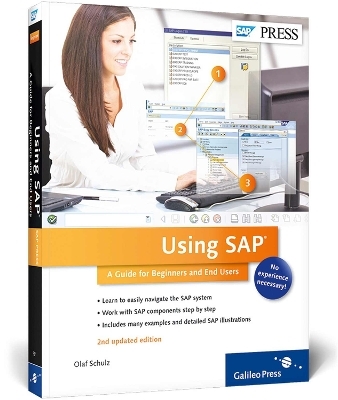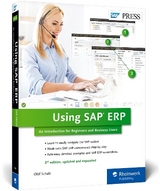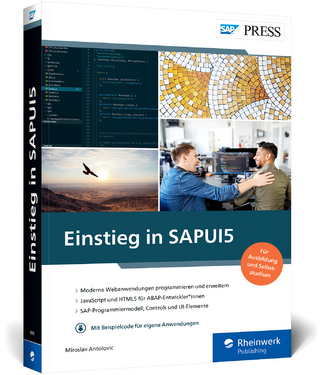
Using SAP
SAP Press (Verlag)
978-1-59229-981-2 (ISBN)
- Titel ist leider vergriffen;
keine Neuauflage - Artikel merken
Don't get trapped in a thicket of confusing IT terms and explanations: Consult this single resource written for you, the SAP user! You'll find detailed steps and screenshots that walk you through the processes you need to do your job: logging on to the system, navigation and maintenance, creating reports, printing, and so much more. Whether you're entering data, using SAP software on a daily basis, or need a foundational knowledge of navigating the SAP system, this book will get you comfortable in no time.
Olaf Schulz works as an SAP consultant and trainer. He has over 15 years of experience in IT and organization, focusing on the following aspects: planning and implementation of trainings, creation of training material, project management, CRM implementation and system support, as well as system development and network administration. In cooperation with user departments, he has analyzed their requirements and implemented them in the SAP system and launched them in the enterprise.
About This Book ... 13
Part I: The SAP Enterprise
1. A Brief History of the SAP Enterprise ... 21
1.1 Getting Started: From RF to SAP R/3 ... 21
1.2 SAP from the Turn of the Millennium to the Present ... 24
2. How Does SAP Software Work? ... 27
2.1 What Is “Standard Software”? ... 27
2.2 Adapting the SAP System to an Enterprise ... 28
2.3 What If the Standard Is Not Sufficient? … 30
2.4 Orientation toward the Process ... 30
2.5 Real Time ... 31
2.6 Central Data—Decentralized Processing ... 32
3. Overview of the Most Critical SAP Products ... 35
3.1 Complete Package: SAP Business Suite ... 35
3.2 The Central Component: SAP ERP ... 36
3.3 Maintaining Customer Relationships: SAP CRM ... 43
3.4 Optimizing Supplier Relationships: SAP SRM ... 44
3.5 The Entire Lifecycle of a Product: SAP PLM ... 44
3.6 For All Supply Chain Elements: SAP SCM ... 45
3.7 Industry Solutions ... 47
3.8 Special Software for Medium-Sized Enterprises ... 48
3.9 The Technical Basis: SAP NetWeaver ... 49
Part II: Basic Principles of System Operation
4. Organizational Structures and Master Data ... 55
4.1 Organizational Structures ... 55
4.2 Master Data ... 62
4.3 Try It! ... 69
5. Logging On to the SAP System ... 71
5.1 SAP Logon ... 71
5.2 Logging On for the First Time ... 74
5.3 Logging On to the System ... 77
5.4 The SAP User Interface ... 78
5.5 Logging Off from the SAP System ... 83
5.6 Try It! ... 84
6. Navigating in the SAP System ... 87
6.1 Overview of the Navigation Options … 87
6.2 Navigating via the SAP Easy Access Menu ... 89
6.3 Navigating via Transaction Codes ... 91
6.4 Entering Data in the SAP System ... 94
6.5 Input Help ... 99
6.6 Working with Sessions ... 100
6.7 Try It! ... 102
7 Maintaining the System Layout and User Data …103
7.1 Creating Links on the Desktop ... 103
7.2 Maintaining Your Own User Data ... 104
7.3 Creating Favorites ... 108
7.4 Holding, Setting, and Deleting Data ... 117
7.5 Adapting the User Interface ... 118
7.6 Try It! ... 120
8. Creating Evaluations and Reports ... 121
8.1 Using Standard Reports in the SAP System ... 121
8.2 Finding Standard Reports ... 125
8.3 Exporting Lists to Microsoft Excel ... 127
8.4 Using Variants ... 130
8.5 Other Reporting Options in SAP ERP ... 131
8.6 Try It! ... 133
9. Printing ... 135
9.1 Overview of the Print Functions ... 135
9.2 Using Spool Requests ... 137
9.3 Changing the Default Printer ... 141
9.4 Creating Screenshots ... 142
9.5 Try It! ... 144
10. Automating Tasks ... 145
10.1 Background Jobs ... 145
10.2 Batch Processing (Batch Input) ... 156
10.3 Try It! … 163
11. Working with Messages and the Business Workplace ... 165
11.1 Overview of the Business Workplace ... 165
11.2 Sending Short Messages ... 167
11.3 SAP Business Workflow ... 170
11.4 Folders ... 171
11.5 Office Organization ... 172
11.6 Try It! ... 175
12. Electronic Data Interchange ... 177
12.1 Overview of the EDI Process ... 177
12.2 EDI in Practice ... 178
12.3 Try It! ... 179
13 Using Help Functions ... 181
13.1 Field Helps and Search Windows ... 181
13.2 The Help Menu ... 185
13.3 Customizing the Help ... 189
13.4 Try It! ... 191
About This Book ... 13
Part I: The SAP Enterprise
1. A Brief History of the SAP Enterprise ... 21
1.1 Getting Started: From RF to SAP R/3 ... 21
1.2 SAP from the Turn of the Millennium to the Present ... 24
2. How Does SAP Software Work? ... 27
2.1 What Is “Standard Software”? ... 27
2.2 Adapting the SAP System to an Enterprise ... 28
2.3 What If the Standard Is Not Sufficient? … 30
2.4 Orientation toward the Process ... 30
2.5 Real Time ... 31
2.6 Central Data—Decentralized Processing ... 32
3. Overview of the Most Critical SAP Products ... 35
3.1 Complete Package: SAP Business Suite ... 35
3.2 The Central Component: SAP ERP ... 36
3.3 Maintaining Customer Relationships: SAP CRM ... 43
3.4 Optimizing Supplier Relationships: SAP SRM ... 44
3.5 The Entire Lifecycle of a Product: SAP PLM ... 44
3.6 For All Supply Chain Elements: SAP SCM ... 45
3.7 Industry Solutions ... 47
3.8 Special Software for Medium-Sized Enterprises ... 48
3.9 The Technical Basis: SAP NetWeaver ... 49
Part II: Basic Principles of System Operation
4. Organizational Structures and Master Data ... 55
4.1 Organizational Structures ... 55
4.2 Master Data ... 62
4.3 Try It! ... 69
5. Logging On to the SAP System ... 71
5.1 SAP Logon ... 71
5.2 Logging On for the First Time ... 74
5.3 Logging On to the System ... 77
5.4 The SAP User Interface ... 78
5.5 Logging Off from the SAP System ... 83
5.6 Try It! ... 84
6. Navigating in the SAP System ... 87
6.1 Overview of the Navigation Options … 87
6.2 Navigating via the SAP Easy Access Menu ... 89
6.3 Navigating via Transaction Codes ... 91
6.4 Entering Data in the SAP System ... 94
6.5 Input Help ... 99
6.6 Working with Sessions ... 100
6.7 Try It! ... 102
7 Maintaining the System Layout and User Data …103
7.1 Creating Links on the Desktop ... 103
7.2 Maintaining Your Own User Data ... 104
7.3 Creating Favorites ... 108
7.4 Holding, Setting, and Deleting Data ... 117
7.5 Adapting the User Interface ... 118
7.6 Try It! ... 120
8. Creating Evaluations and Reports ... 121
8.1 Using Standard Reports in the SAP System ... 121
8.2 Finding Standard Reports ... 125
8.3 Exporting Lists to Microsoft Excel ... 127
8.4 Using Variants ... 130
8.5 Other Reporting Options in SAP ERP ... 131
8.6 Try It! ... 133
9. Printing ... 135
9.1 Overview of the Print Functions ... 135
9.2 Using Spool Requests ... 137
9.3 Changing the Default Printer ... 141
9.4 Creating Screenshots ... 142
9.5 Try It! ... 144
10. Automating Tasks ... 145
10.1 Background Jobs ... 145
10.2 Batch Processing (Batch Input) ... 156
10.3 Try It! … 163
11. Working with Messages and the Business Workplace ... 165
11.1 Overview of the Business Workplace ... 165
11.2 Sending Short Messages ... 167
11.3 SAP Business Workflow ... 170
11.4 Folders ... 171
11.5 Office Organization ... 172
11.6 Try It! ... 175
12. Electronic Data Interchange ... 177
12.1 Overview of the EDI Process ... 177
12.2 EDI in Practice ... 178
12.3 Try It! ... 179
13 Using Help Functions ... 181
13.1 Field Helps and Search Windows ... 181
13.2 The Help Menu ... 185
13.3 Customizing the Help ... 189
13.4 Try It! ... 191
14 The Role and Authorization Concept ... 193
14.1 Authorizations ... 193
14.2 Roles ... 194
14.3 Try It! … 197
Part III The Most Critical SAP Components
15. Materials Management ... 201
15.1 Materials Management Task Areas ... 201
15.2 Organizational Structures ... 205
15.3 Master Data ... 206
15.4 Purchase Order ... 219
15.5 Inventory Management ... 222
15.6 Invoice Verification ... 226
15.7 Automatic Material Requirements Planning ... 230
15.8 Evaluations ... 232
16. Sales and Distribution ... 235
16.1 Sales and Distribution Task Areas ... 235
16.2 Organizational Structures ... 238
16.3 Master Data ... 239
16.4 Sales Order Processing ... 246
16.5 Availability Check ... 251
16.6 Complaint Processing (Returns) ... 253
16.7 Evaluations ... 254
17. Financial Accounting ... 257
17.1 Financial Accounting Tasks ... 257
17.2 Organizational Structures in Financial Accounting ... 261
17.3 General Ledger Accounting ... 262
17.4 Accounts Payable Accounting ... 266
17.5 Accounts Receivable Accounting ... 279
17.6 Evaluations ... 285
18. Controlling ... 289
18.1 Task Areas in Controlling ... 289
18.2 Organizational Structures ... 294
18.3 Overhead Cost Controlling ... 295
18.4 Product Cost Controlling ... 301
18.5 Profitability Analysis ... 305
18.6 Evaluations ... 309
19 Human Resources ... 311
19.1 Tasks in SAP Human Resources ... 311
19.2 Organizational Management ... 313
19.3 Recruitment ... 316
19.4 Personnel Administration ... 320
19.5 Talent Management ... 323
19.6 Time Management … 324
19.7 Payroll ... 326
19.8 Standard Reporting ... 329
20. Case Study ... 331
20.1 The Sample Business ... 333
20.2 The Enterprise Structure ... 333
20.3 Creating Material Master Records ... 335
20.4 Creating Vendor Master Records ... 336
20.5 Creating Purchasing Info Records ... 337
20.6 Creating a Purchase Order ... 339
20.7 Receiving Goods ... 341
20.8 Verifying an Invoice ... 342
20.9 Displaying Open Items (Optional) ... 344
20.10 Posting Outgoing Payments ... 345
20.11 Creating a Customer Master ... 346
20.12 Adding Sales Data to the Material Master Record ... 348
20.13 Creating Conditions ... 349
20.14 Creating a Standard Order ... 350
20.15 Delivering and Issuing Goods ... 351
20.16 Creating an Invoice ... 353
20.17 Posting Incoming Payments ... 354
Appendices
A. Abbreviations ... 359
B. Glossary... 363
C Buttons, Key Combinations, and Function Keys ... 373
D The Author... 379
Index ... 381
14. The Role and Authorization Concept ... 193
14.1 Authorizations ... 193
14.2 Roles ... 194
14.3 Try It! … 197
Part III The Most Critical SAP Components
15. Materials Management ... 201
15.1 Materials Management Task Areas ... 201
15.2 Organizational Structures ... 205
15.3 Master Data ... 206
15.4 Purchase Order ... 219
15.5 Inventory Management ... 222
15.6 Invoice Verification ... 226
15.7 Automatic Material Requirements Planning ... 230
15.8 Evaluations ... 232
16. Sales and Distribution ... 235
16.1 Sales and Distribution Task Areas ... 235
16.2 Organizational Structures ... 238
16.3 Master Data ... 239
16.4 Sales Order Processing ... 246
16.5 Availability Check ... 251
16.6 Complaint Processing (Returns) ... 253
16.7 Evaluations ... 254
17. Financial Accounting ... 257
17.1 Financial Accounting Tasks ... 257
17.2 Organizational Structures in Financial Accounting ... 261
17.3 General Ledger Accounting ... 262
17.4 Accounts Payable Accounting ... 266
17.5 Accounts Receivable Accounting ... 279
17.6 Evaluations ... 285
18. Controlling ... 289
18.1 Task Areas in Controlling ... 289
18.2 Organizational Structures ... 294
18.3 Overhead Cost Controlling ... 295
18.4 Product Cost Controlling ... 301
18.5 Profitability Analysis ... 305
18.6 Evaluations ... 309
19 Human Resources ... 311
19.1 Tasks in SAP Human Resources ... 311
19.2 Organizational Management ... 313
19.3 Recruitment ... 316
19.4 Personnel Administration ... 320
19.5 Talent Management ... 323
19.6 Time Management … 324
19.7 Payroll ... 326
19.8 Standard Reporting ... 329
20. Case Study ... 331
20.1 The Sample Business ... 333
20.2 The Enterprise Structure ... 333
20.3 Creating Material Master Records ... 335
20.4 Creating Vendor Master Records ... 336
20.5 Creating Purchasing Info Records ... 337
20.6 Creating a Purchase Order ... 339
20.7 Receiving Goods ... 341
20.8 Verifying an Invoice ... 342
20.9 Displaying Open Items (Optional) ... 344
20.10 Posting Outgoing Payments ... 345
20.11 Creating a Customer Master ... 346
20.12 Adding Sales Data to the Material Master Record ... 348
20.13 Creating Conditions ... 349
20.14 Creating a Standard Order ... 350
20.15 Delivering and Issuing Goods ... 351
20.16 Creating an Invoice ... 353
20.17 Posting Incoming Payments ... 354
Appendices
A. Abbreviations ... 359
B. Glossary... 363
C Buttons, Key Combinations, and Function Keys ... 373
D The Author... 379
Index ... 381
| Erscheint lt. Verlag | 30.8.2014 |
|---|---|
| Reihe/Serie | SAP Press |
| Verlagsort | Maryland |
| Sprache | englisch |
| Maße | 175 x 228 mm |
| Themenwelt | Mathematik / Informatik ► Informatik ► Netzwerke |
| Informatik ► Weitere Themen ► SAP | |
| Wirtschaft ► Betriebswirtschaft / Management | |
| Schlagworte | Automating tasks • Help functions • Log on/off • Master Data • Office administration • printing • SAP components • SAP ERP; Einführung • System navigation |
| ISBN-10 | 1-59229-981-4 / 1592299814 |
| ISBN-13 | 978-1-59229-981-2 / 9781592299812 |
| Zustand | Neuware |
| Haben Sie eine Frage zum Produkt? |
aus dem Bereich



